Podcast: Play in new window | Download
Subscribe: Apple Podcasts | RSS
In this episode 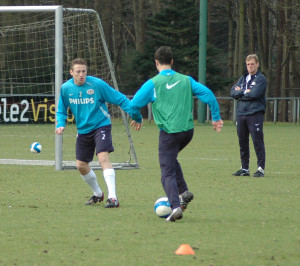 I show you six practice environments that I use for 1v1 training. They focus on each of the key 1v1 situations that players will face in the game. Each of them gives you an opportunity to train both the attacker and defenders. They all allow the players to be very creative and free to try new skills.
I show you six practice environments that I use for 1v1 training. They focus on each of the key 1v1 situations that players will face in the game. Each of them gives you an opportunity to train both the attacker and defenders. They all allow the players to be very creative and free to try new skills.
1v1 situations are such an important part of the game that coaches at every level should be spending at least some of their valuable training time in these types of environments.
Broken down to its most basic elements, soccer is a series of 1v1 games all over the field. The objective of each one is different. Sometimes it’s to keep possession and find a pass. Another time it may be to win a loose ball. In the attacking third the objective may be to create enough space for a cross. In front of goal the 1v1 is a battle between a player trying score and one trying to stop him.
When we’re designing our training environments we need to keep in mind that all of these situations are important and be sure that each one is addressed with a different exercise or game. If we plan well, we can even train more than one of these aspects of 1v1 at the same time.
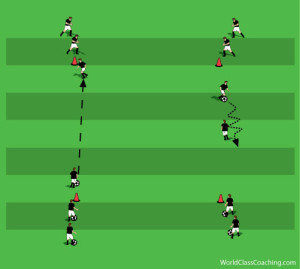
Before I do 1 v 1 training with my players I like to teach them a few moves to give them ideas about how they can break down defenders.
An easy way to work on these moves is to create two lines facing each other. At first both players can have a ball and they dribble toward each other and perform the same move (with the same foot) and then dribble past each other.
You can then progress to having one player pass to the other and then pressure him. First passively, only jogging toward the attacker. Then you can make the defender more active to challenge the defender.
This is also an opportunity to teach defensive positioning and tactics.
These are my six favorite training environments to work on 1 v 1 situations.
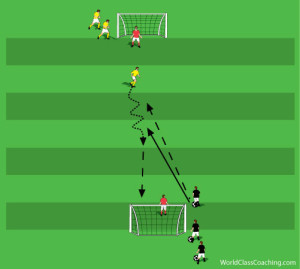
Two Line – One Next to Each Goal
Defender passes to the attacker and pressures. The attacker attempts to beat the defender and score.
If the defender wins the ball they can attack the other goal.
Two Lines – Defenders to One Side
As before but now the defenders are running to the get in front of the attackers. The attackers can take advantage of this by tricking the defender into over-committing or by driving inside and then taking the ball outside.
Two Lines – One on Each Side of the Field
The defenders are now forced to move across more quickly which creates an even greater likelihood that the defender will over-commit.
Two Lines – Recovering Defender
Now the defender passes in front of the attacker who takes his first touch toward goal. The defender attempts to recover to a goalside position.
You can increase or decrease the pressure on the attacker by changing the position of the line of attackers. Move them farther back and the defender has a greater chance to recover. Move them farther forward and they’ll have more time before the defender can arrive.
Two Lines – Down the Line
The defender plays the ball in front of the attacker who tries to beat the defender and create a chance to shoot.
If the defender wins the ball he can move to attack the other goal.
Move the lines to the other side of the field to work on shooting with the other foot.
Diagonal Continuous Game
The attacker must get the ball into the ‘scoring zone’ before they can shoot. As soon as they shoot an attacker from the other team comes on to the field and tries to score in the goal diagonally across from them. Each time an attacker shoots they immediately become a defender.
1 v 1 Team Keep Away
Players are matched up and compete to keep the ball. At irregular intervals the coach stops the game and counts the number of soccer balls each team possesses. The team with the most wins a point for that round. You can play for a set period of time or until one team reaches 10 points.
1 v 1 Round Robin Tournament
The ideas and methodology behind this competition are described in ‘Training Soccer Legends’ by Andy Barney.
Each player in the session plays every other player in game that lasts from two to three minutes, depending on the number of players in the session. If the attacker scores they keep the ball and attack in the other direction. This ‘make-it-take-it’ format encourages the players to work hard defensively or they will not get a chance to attack.
At the end of each round the score of each player is recorded. If a player wins their score is recorded as 2-1. If they lose the score is recorded as 1-2. At the end of the session each player’s score is calculated so that they each have a total number of goals scored, goals against and goal difference. They are also ranked in each of these categories.
You can download a PDF of the 1 v 1 Round Robin Matrix and Score Sheet by clicking the link.
1 v 1 Rotation
The same format is used but it is NOT ‘make-it-take-it’ and each game is played until one player scores three goals. At the end of each game the players in come to the side and wait for another game to end. The winners of each game play next as do the players who lost each match-up.
The first player to win three match-ups wins the competition.
These are the six different environments I use to train 1v1 situations. Over the years I’ve found that they effectively teach players how to deal with each of the situations they face in the game.
No matter what age group or ability level you’re working with, 1v1 games should be an important part of your training plan.
Printable Show Notes
The show notes for each episode are accessed through the WCC Training Center.
They are FREE but you will need at least a Free Membership to the Training Center in order to view and print them.
Click on the image of the notes and if you’re already logged in to the Training Center you’ll be taken to the Podcast page. If you’re not logged in your be taken to a login page where you’ll also be able to login or register if you are not already a Member.
Remember!
Make sure you subscribe to Coaching Soccer Weekly through iTunes, or your podcast provider of choice, to be sure you never miss an episode.
We would appreciate it if you would leave us a 5 star rating and/or a written review on iTunes to help spread the word about the show and ensure that we can continue to bring you top notch guests in the future.
In the Next Episode
In next week’s episode I will share a complete training session to help your players learn to combine in order to get behind the defense and create goal scoring chances.


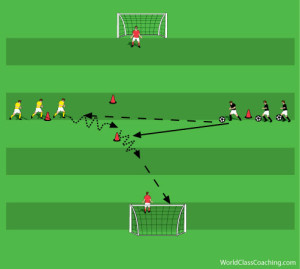
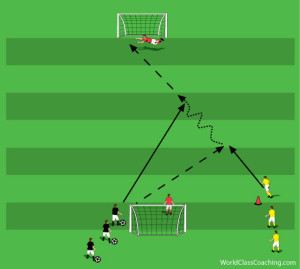

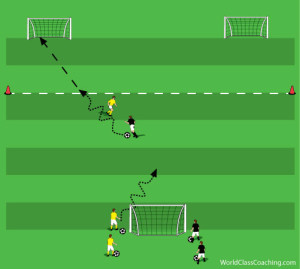
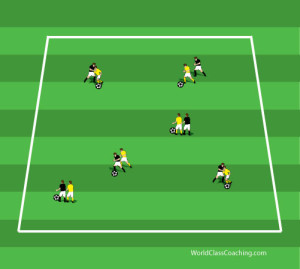
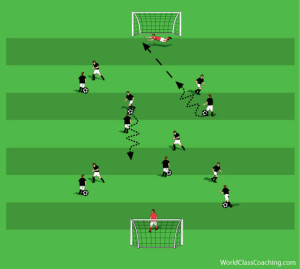

very intresting trainning sections,if proparly followed in ream practice it sure going to improve goal scoring in a team.
I’m glad you found it useful Ajanah.
Its good.
I really enjoy your episode you show six practice 1 v 1 training.
thank you so much.
really iam gat a gd benefit from the drill…hope to recieve more ,,,thank u for the efforts ..
First (of your) podcasts to which I’ve listened – great resource, thank you!
You requested suggestions – you already do this to an extent, but it would be helpful to note variations of drills based upon age group. I’ve been coaching my child’s team for three years and they are arriving at an age (9-10) where skills are truly beginning to form. My playing experience has been very limited so I’m grateful for resources like your site and podcast.
Hans,
I’m glad you are enjoying the podcast.
That’s a great suggestion. I’ll try to give variations of every exercise I describe in the future.
Thanks for the feedback. Feel free to let me know if there’s anything else I can do to improve the show in the future.
Really like this drills gives me more tools to work with my team I’m sure my lads will like it thanks
Leo,
I hope they enjoy it. Please let us know if you come up with any variations or progressions that work well for your team.
Great stuff, thanks as always
1v1 always useful to extend a session with or to use if numbers are low. Great stuff as usual.